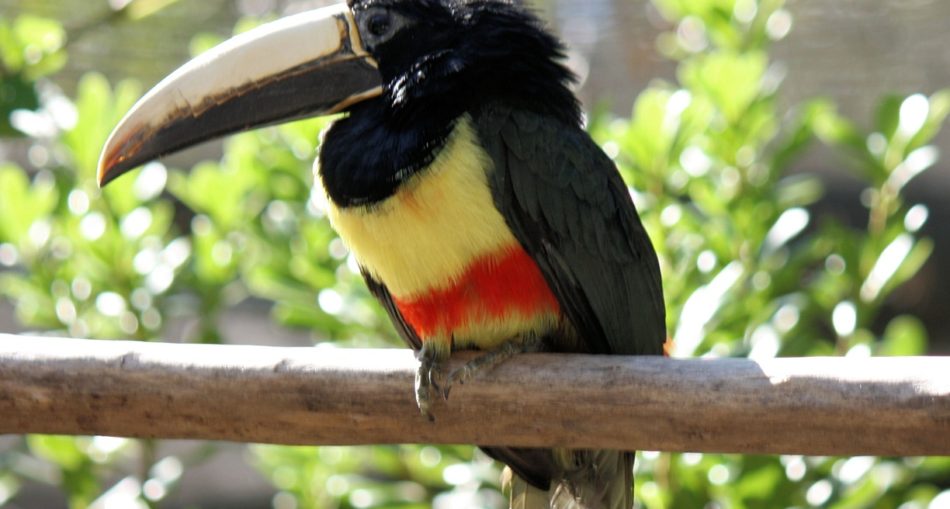From afar you might mistake this bird for the toucan because of its intense colours and the shape of its bill. However, the black-necked aracari has its own personality and is classified in a different genus. Nevertheless, the black-necked aracari and the toucan are similar in some ways; they are actually from the same family. Like toucans, aracaris have a large bill compared to their body. Although, this does not seem to inhibit their activities. Aracaris live in holes or hollows high in trees. The nesting site consists of one or several nest holes, because a pair will move to a new nesting hole if disturbed.
From afar you might mistake this bird for the toucan because of its intense colours and the shape of its bill. However, the black-necked aracari has its own personality and is classified in a different genus. Nevertheless, the black-necked aracari and the toucan are similar in some ways; they are actually from the same family. Like toucans, aracaris have a large bill compared to their body. Although, this does not seem to inhibit their activities. Aracaris live in holes or hollows high in trees. The nesting site consists of one or several nest holes, because a pair will move to a new nesting hole if disturbed.
Features Of The Black-necked Aracari
- Color – Black-necked aracaris have a black head and throat with dark green to almost black back and tail. Its undersides are yellow with a red band and a rump.
- Bill – The upper bill (maxilla) is ivory and the lower bill (mandible) is black.
- Weight & Length – The black-necked aracari measures 35–45 cm (14–18 in) long and weighs 177-309 grams (6-10.9 oz.)
Scientific Classification Of The Black-necked Aracari
Black-necked Aracari – Pteroglossus aracari [Scientific name]
- Kingdom: Animalia
- Phylum: Chordata
- Class: Aves
- Order: Piciformes
- Family: Ramphastidae
- Genus: Pteroglossus
- Species: P. aracari
Subspecies
Three subspecies are recognized:
- a. atricollis – (Statius Müller, PL, 1776): Originally described as a separate species. Found in eastern Venezuela, the Guianas and northern Brazil
- a. aracari – (Linnaeus, 1758): Found in north-eastern, eastern and south-eastern Brazil
- a. wiedii – Sturm, JHCF & Sturm, JW, 1847: Originally described as a separate species in the genus Pteroglossus. Found in south-eastern Brazil
Habitat Of The Black-necked Aracari
The black-necked aracari can be found in a variety of forest and woodland habitats in Brazil, French Guiana, Guyana, Suriname, and Venezuela. Its natural habitats are subtropical or tropical moist lowland forests and heavily degraded former forest.
Did You Know? The black-necked aracari (Pteroglossus aracari), is a species of bird in the toucan family.
Diet Of The Black-Neck Aracari
The diet of the black-necked aracari consists of fruit, nuts and animal prey.
Tip: The black-necked aracari was originally classified in the genus Ramphastos. Alternative names include beautiful aracari and Maximilian’s aracari.
Reproduction Of The Black-necked Aracari
The season for mating is roughly February to August. Two to four white eggs are laid. Nests are in old tree cavities (such as those made by woodpeckers); both sexes incubate for a period of 16-17 days. It is noted that the male will feed the hen while she incubates eggs. In captivity, their nests are typically constructed from palm tree logs. Some may use nest boxes. Both parents feed the chicks, often by regurgitating food items. Fledging occurs at approximately 40 days, at which point it is thought the chicks become ‘non-breeders’ within a flock.
Chicks: The newly hatched chicks are blind and naked with short bills and thick pads on their heels to protect them from the rough floor of the nest. Both parents, as well as their previous offspring and/or possibly other adults, feed the chicks. The adults continue to feed them for several weeks after fledging.
10 Facts About The Black-necked Aracari
- This is a very noisy bird that shrieks constantly.
- Black-necked aracaris live in flocks of eight to ten individuals.
- They will migrate over long distances in search of food. Their main predators are larger birds of prey.
- They are classified as Least Concern (LC) on IUCN Red List; CITES, Appendix II.
- The black-necked aracari nests in hollows in the trees created by either woodpecker or by broken tree branches.
- Aracaris generally roost socially throughout the year.
- Up to five adults and their fledged offspring sleep in the same hole with their long tails folded over their backs.
- Captive birds are docile, easy to breed, and typically do well in large, planted flights.
- Breeding pairs are best kept alone.
- Captive birds may breed in nest boxes with a concave bottom; however, they generally prefer natural nests constructed from palm tree logs, which allows them to dig their nest chambers deeper.
Black-Necked Aracari In Guyana
This article would have shown you that the black-necked aracari (Pteroglossus aracari) is a South American bird that occurs naturally in Brazil, French Guiana, Guyana, Suriname, and Venezuela, where it inhabits a variety of forest and woodland habitats. Yes, this beautiful multicolored bird has a black head, an olive-green back, and a bicoloured bill: pale or ivory above and black below. It also has a striking red band across its yellow underparts and its red rump. This bird is commonly encountered in a variety of different forested habitats, where it typically gathers in small noisy groups, occasionally with other aracari and toucan species at fruiting trees. Yes, this bird has its own unique features with a remarkable personality.
Article References:
- https://en.wikipedia.org/wiki/Black-necked_aracari
- https://ebird.org/species/blnara1
- https://dwazoo.com/animal/black-necked-aracari/
- https://www.beautyofbirds.com/blackneckedaracaris.html
- Main Image: By mattb4rd – IMG_4030Uploaded by snowmanradio, CC BY 2.0, https://commons.wikimedia.org/w/index.php?curid=16882212







